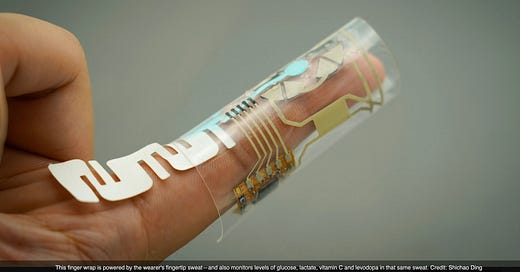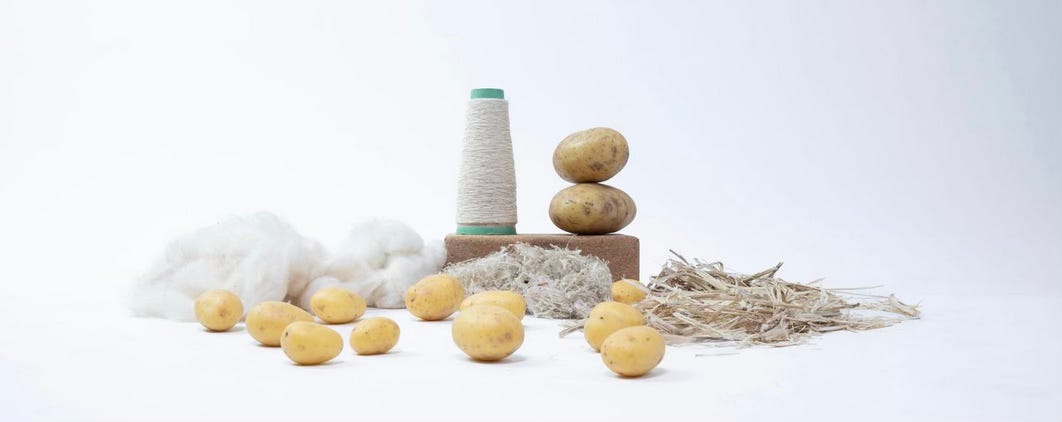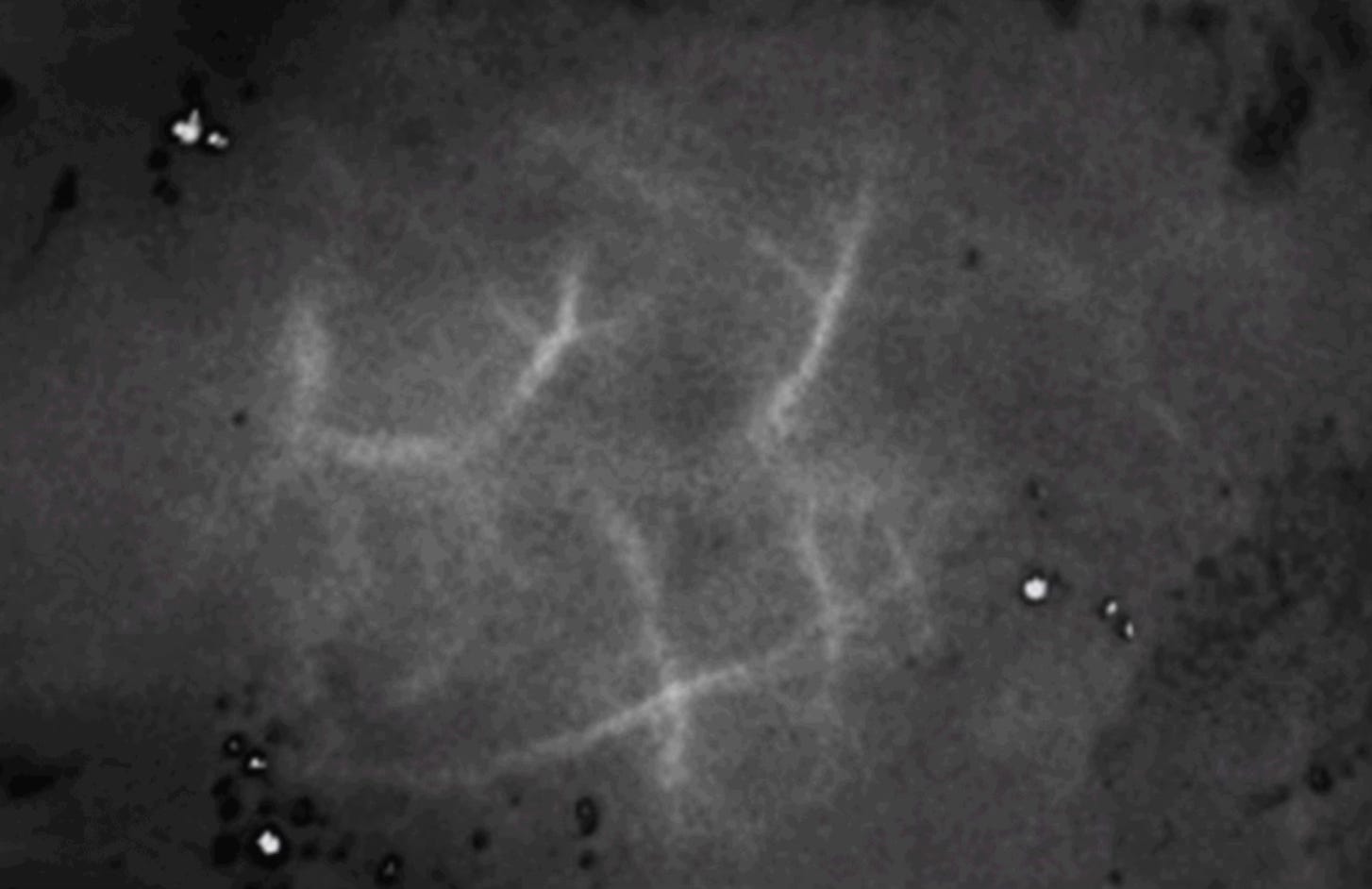This week we examine a new way to monitor our health via our fingertips. We investigate a new method that turns potato waste into clothes and we discover another new paint that will cool our buildings. Finally we find out what common food additive turns mice transparent.
Fingertip Health Monitoring
A team at University of California, San Diego have developed an electronic finger wrap that will provide continuous, personalized health monitoring. The wrap monitors chemical levels such as glucose, vitamins and various drugs via the sweat from our fingertips.
The device wraps around your finger like a bandaid and is powered by the sweat from your finger. Our fingertips are one of the most prolific sweating areas of the body. The tips have over a thousand sweat glands and can produce 100 to 1,000 times more sweat than most other areas of the body. We even sweat through our fingers when we are at rest and during our sleep.
The device has a thin polymer base with several electronic components printed on top. The design allows it to move with the finger during repeated bending and stretching.
Biofuel cells are positioned at the fingertip of the device. These cells collect and convert the chemicals in our sweat into electricity. A pair of stretchable silver chloride-zinc batteries store the power for the four sensors in the device. The sensors each monitor one of, glucose, vitamin C, lactate and levodopa (a drug used for treating Parkinson’s). Data is transmitted via bluetooth to a smartphone or laptop app.
The device could be customized to the user by varying the biomarkers that the sensors are monitoring. The team is working to add the administration of treatments that are required based upon the monitoring. For example, for someone with diabetes, the device would monitor glucose levels and automatically administer insulin as required.
Turing Potato Waste into Clothes
London based startup, Fibe have developed the world’s first textile fibre from potato harvest waste. The leftover stems and leaves of potato plants are the world’s largest untapped agricultural feedstock. Currently this waste is incinerated. It cannot be fed to livestock or turned into fertilizer. 150 million tons of potato waste is burnt every year.
Fibe’s process uses several biological and mechanical steps to extract the fibers from waste potatoes. The chemical free process out performs many of the emerging eco-textiles such as hemp. The process uses 99.7% less water and emits 82.4% less pollutants than cotton. No additional land is required for raw material cultivation.
The fibers are very thin which makes the clothes very soft whilst still maintaining the strength, durability and dye-ability of other plant fibers. The natural antimicrobial compound solanine is also found in the potato fibers.
The company estimates that the current waste from potato crops could provide 70% of the global non-synthetic clothing demand. The fibre can be used in the current spinning and weaving infrastructure used by the clothing industry. Fibe has raised its’ seed investment round and is working towards commercialization of the process and fiber.
Cooling Paint
We have spoken previously about several different new paints that can better reflect sunlight and heat and thus reduce the cooling required in out buildings. A team from NorthEastern University in Boston has developed another new paint that may significantly reduce the heat absorbed by buildings, roads and rooftops.
The paint differentiates itself by using a nanotechnology that draws heat out of buildings in addition to reflecting the light and heat from the buildings. The paint will send infrared radiation into space via wavelengths that are not absorbed by the Earth’s atmosphere.
The new materials are designed to be integrated with various paints and coatings. Tests on storage sheds in Texas and Virginia have shown an indoor temperature drop of at least 5C. The paint is self cleaning, fire resistant and environmentally friendly.
Planck Energies is commercializing the technology and is currently working with 3M to incorporate the technology into paint that can be sprayed onto the roofs of food warehouses, data centers and refrigerator trucks. The goal is to have a product ready for use within 15 to 18 months. Longer term the product could be applied to houses, apartment buildings, roads and walking paths.
Transparent Mice
A team at Howard Hughes Medical Institute in Auburn Virginia have discovered that the dye that gives Doritos their orange hue can also turn mouse tissue transparent. Applying the dye to the skin of mice can allow researchers to look through tissues at the structures inside the mouse including blood vessels and internal organs.
The technique works by changing how body tissues that are usually opaque interact with light. The fluids, fats and proteins that make up skin and muscle have different refractive indices. Aqueous components have low refractive indices, whereas lipids and proteins have high refractive indices. Adding the dye that strongly absorbs light to the tissues narrows the gap between the various refractive indices enough to make them transparent.
The dye, tartrazine was dissolved in water where it makes the water bend light more like how fats bend light. A tissue containing fluids and lipids becomes transparent when the dye is added due to the light refraction of fluids that matches the lipids. The technique can make tissues transparent to around 3mm. It is of use with smaller animals but not larger animals. When the dye is washed off the skin returns to normal.
The ability to produce transparency and reverse it on live animals will make the technique extremely useful for many research projects. In particular it may help us develop a better understanding of the nervous systems and potentially neurodegenerative diseases.
If Doritos turn mice transparent, what is it doing to your insides? Something to look into.
Paying it Forward
If you have a start-up or know of a start-up that has a product ready for market please let me know. I would be happy to have a look and feature the startup in this newsletter. Also if any startups need introductions please get in touch and I will help where I can.
If you have any questions or comments please comment below.
I would also appreciate it if you could forward this newsletter to anyone that you think might be interested.
Till next week.






